Introduction #
Imagine being Frank Lloyd Wright, juggling multiple commissions at once. One client wants cutting-edge modernism, the other demands classical grandeur, and somehow, you have to make both masterpieces work. If that wasn’t enough, somehow each client had the brilliant idea, “What’s better than one architect? Two architects!” As a result, you’ve been paired with another architect to negotiate with and collaborate on each commission. Great…
That’s Between Two Castles Essential Edition in a nutshell. The game takes the shared decision-making of Between Two Cities and the room-scoring puzzle and post-Napoleonic theme of Castles of Mad King Ludwig and smashes them together into one brain-burning, but surprisingly approachable hybrid. So, does this peculiar blend of cooperation and competition work? Most importantantly, does it work solo? Let’s find out.
Overview #
Each turn, players select two room tiles from their hand and work with their partners to place one tile in each of their castles. These tiles represent various rooms—ballrooms, libraries, dungeons, and more—each with specific placement rules and scoring conditions. Strategic tile placement is crucial, as rooms grant points based on adjacency, room type diversity, and other criteria. Completing a set of same-type rooms grants powerful bonus actions that help you make your castle even more splendid.
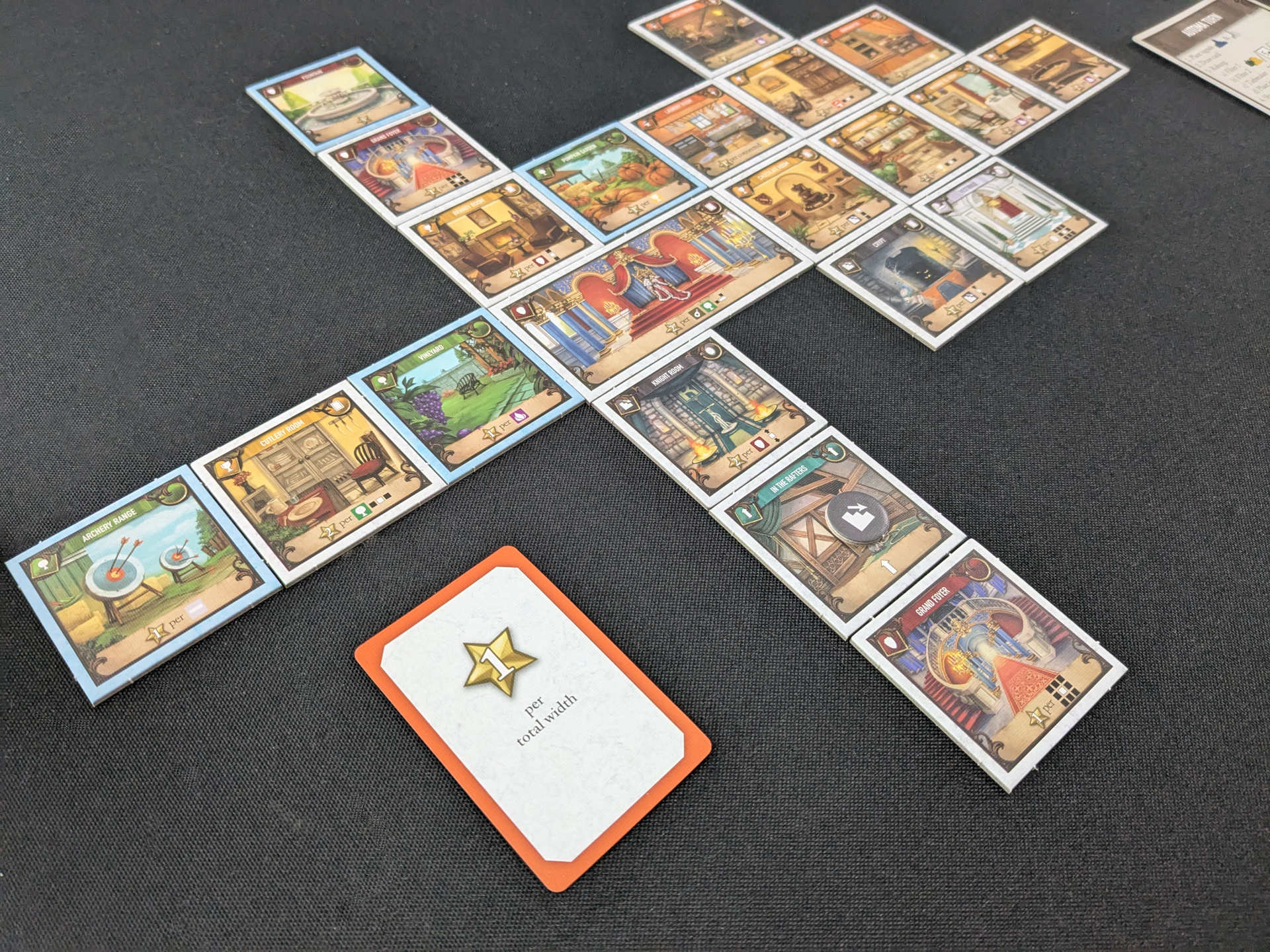
The game plays out over two rounds, with players drafting and placing tiles, earning bonuses for completing sets of room types, and attempting to maximize the value of both castles they are helping to construct. But there’s another catch: your final score is determined by the lower scoring of the two castles you worked on. This means you can’t neglect either of your masterpieces—you must balance your efforts and ensure both castles are as impressive as possible.
Gameplay #
First things first—if you’ve played Castles of Mad King Ludwig, you’ll appreciate that Between Two Castles Essential Edition is much faster to set up and tear down. You won’t be wrestling with a million different room shapes and sizes. More or less you just grab a throne room and a stack of tiles per player and you’re ready to start playing.
This is the essential edition so it comes with the Secrets & Soirees expansion too. This expansion is integrated from the start and I find that it integrates seamlessly—so much so that I don’t see a reason to play without it.
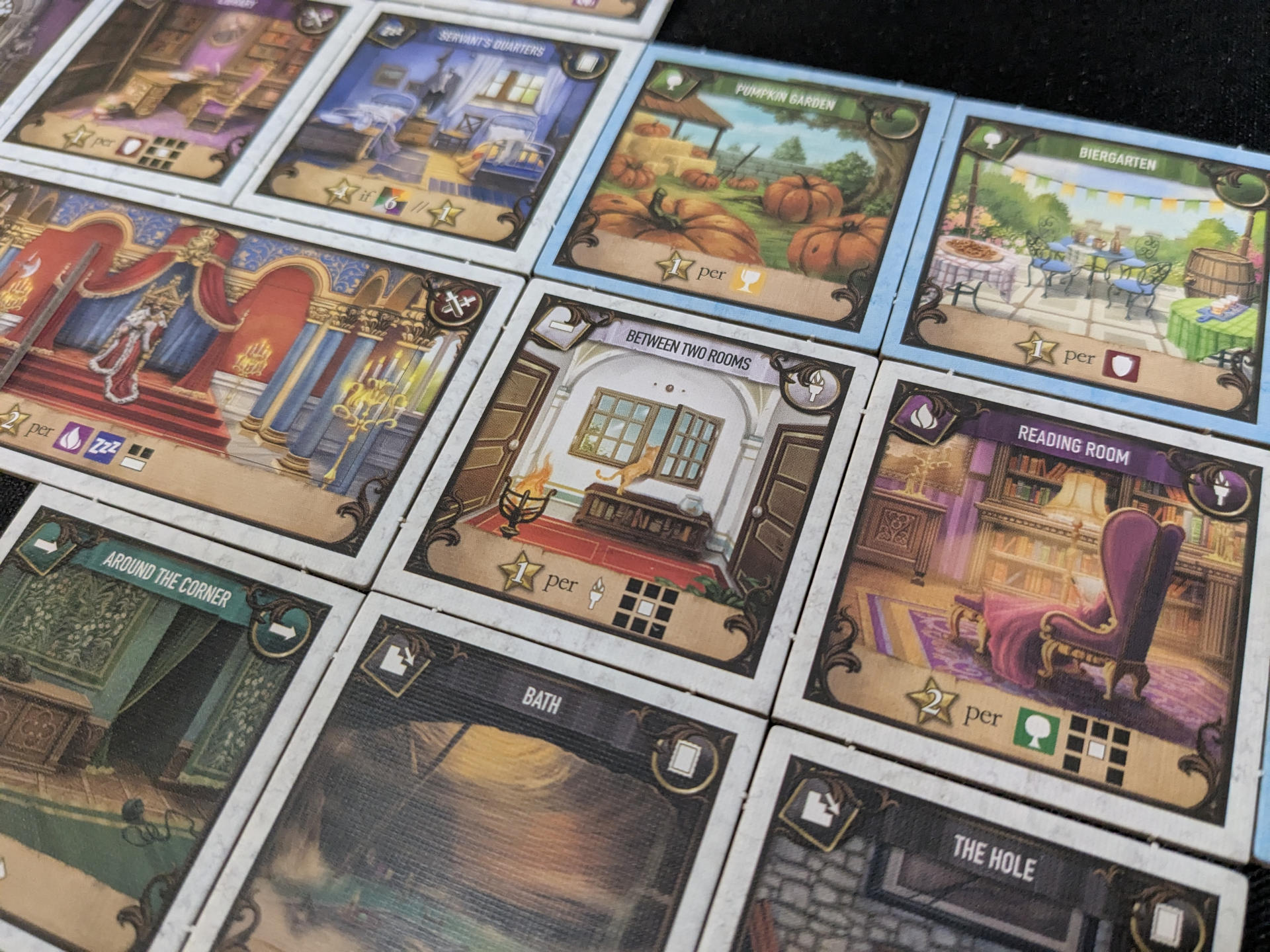
The tile-laying and adjacency scoring work well in this game and the rules are not hard to grasp. Each room type has consistent scoring rules, which makes the game easier to play as you interalize the different room types. Unfortunately, this streamlined gameplay decision does lead to castle that feel less plausible and less creative.
Then there are the competing demands of room scoring rules, providing stable support for building your castle upwards and making do with the rooms available. Combined, this can make for inconvenient tile placements like when a tetromino lands where you didn’t want it to in Tetris. Unlike Tetris, though, there’s no way to recover from a mistake. If a room loses its scoring potential due to poor placement, you’re stuck with it.
Where the game thrives is with its powerful set bonuses. Every time you complete a set of the same room type, you unlock a bonus, and these moments feel great. Whether it’s a well-timed bonus that cascades into another or a tough decision between a fixed number of points versus a more risky but potentially higher-scoring option, these choices make for some seriously exciting turns.
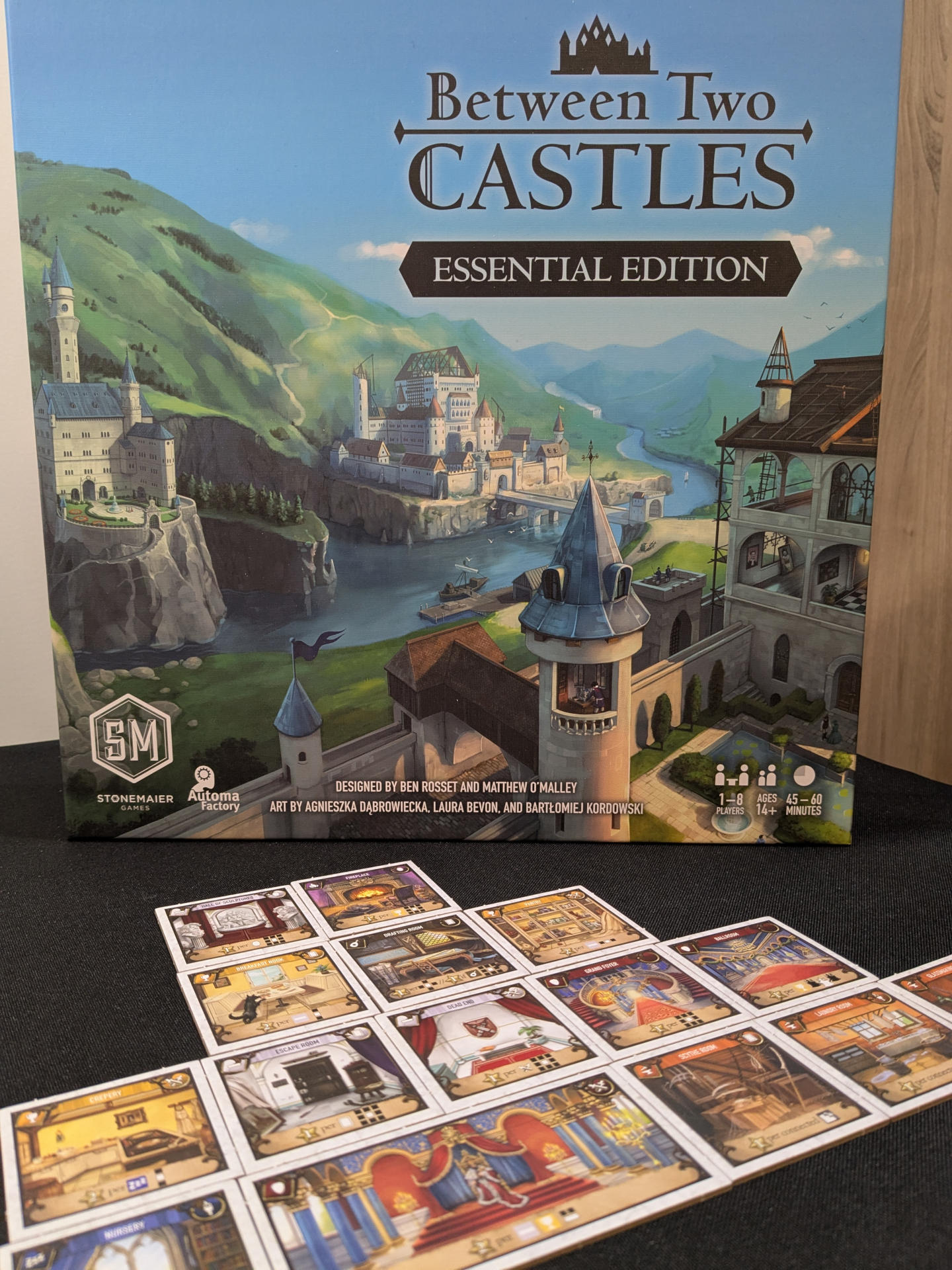
Another standout mechanic is the highest-lowest score win condition. It keeps the game engaging, as you can’t just optimize one castle and ignore the other. Unlike some games where your attention feels split between two separate areas, here, it actually makes the experience better. Every choice carries more weight, and the balancing act keeps turns interesting.
Finally, I found scoring to be rather quick and painless thanks to a well-designed scoring pad, which walks you through everything room by room.
Solo Play #
Given how much of Between Two Castles Essential Edition relies on cooperation, you’d think the solo mode would feel tacked on. But surprisingly, it works really well.
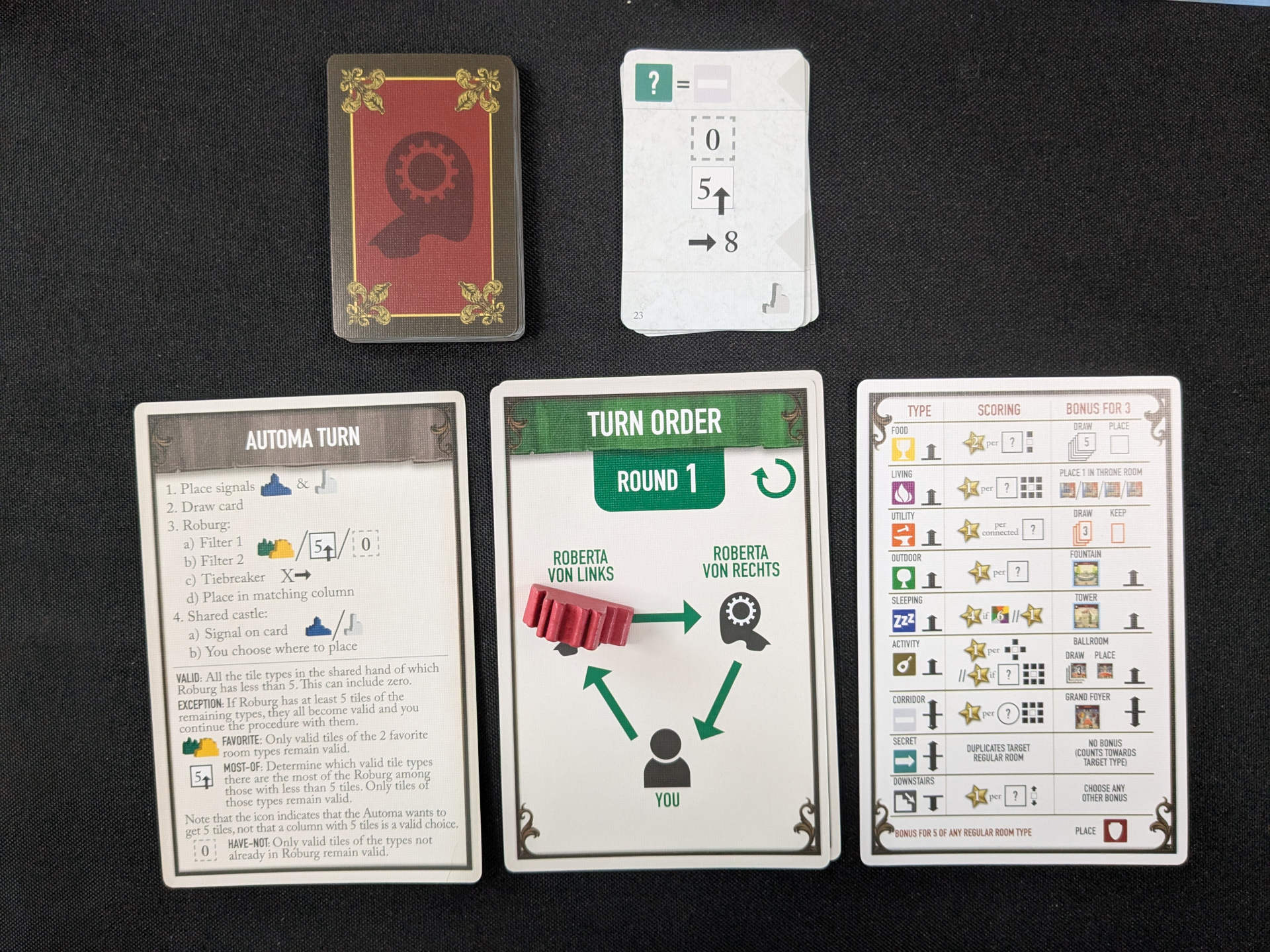
The automa is another masterful design from Morten Monrad Pedersen of Automa Factory. It’s a simulated opponent that is simple to run without altering the game by removing core mechanics. You’re actually running two automas as you play and it does a great job capturing some of the cooperative spirit. You’re able to make recommendations to the automa for the room it should draft for your shared castle, but the automa maintains some autonomy by making the final choice, keeping things unpredictable.
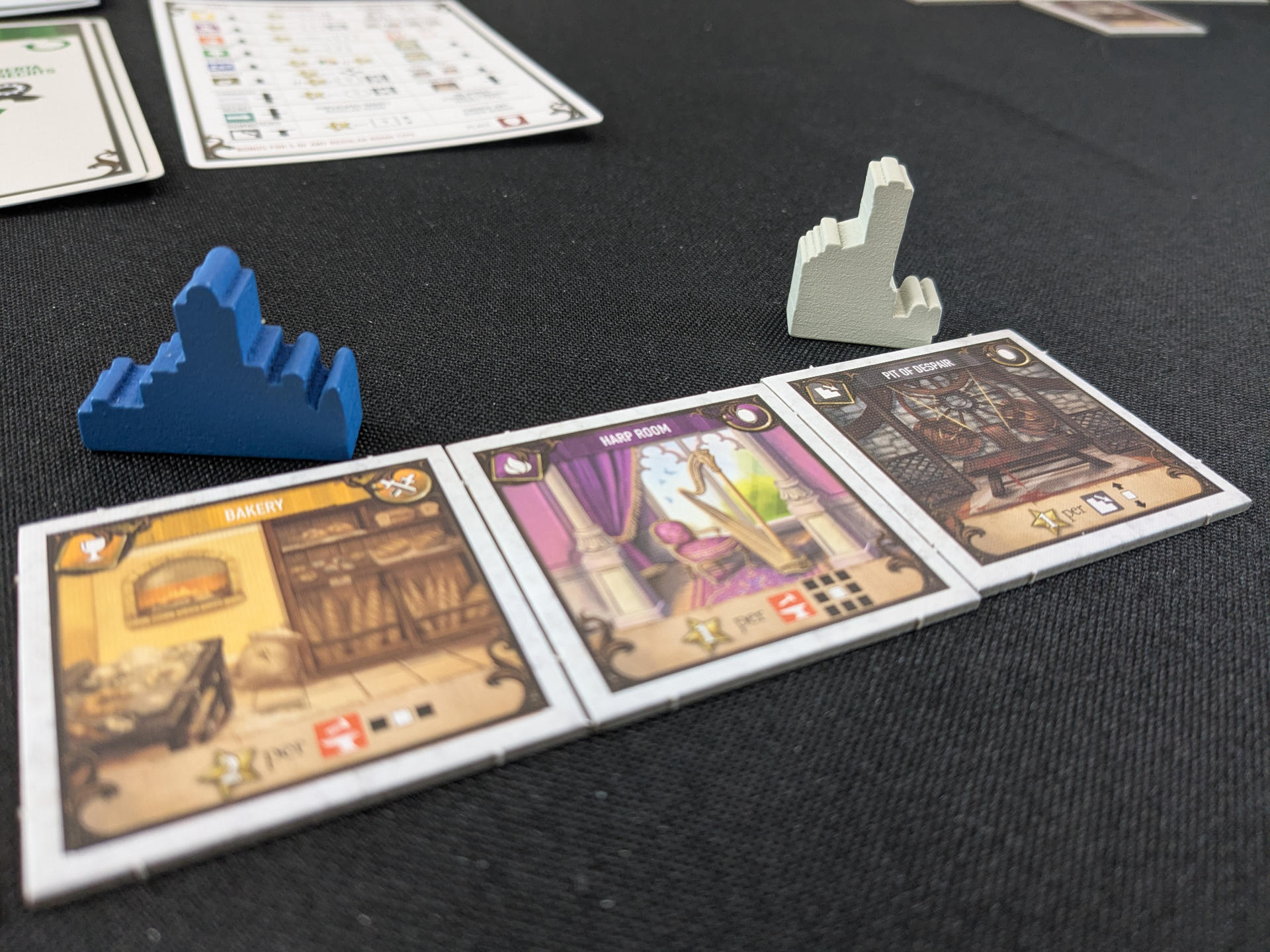
Instead of the usual closed-hand drafting, solo play uses an open-hand draft with one hand of tiles at a time. While part of me wishes I could see three hands at once for better strategizing, I think that would be way too much to track alongside running the automas. The designers made a smart trade-off here.
Strategically, I liked that denying useful rooms for Roburg, the third castle you aren’t working on, is a valid and effective strategy towards the end of the game or when you don’t have good room choices.
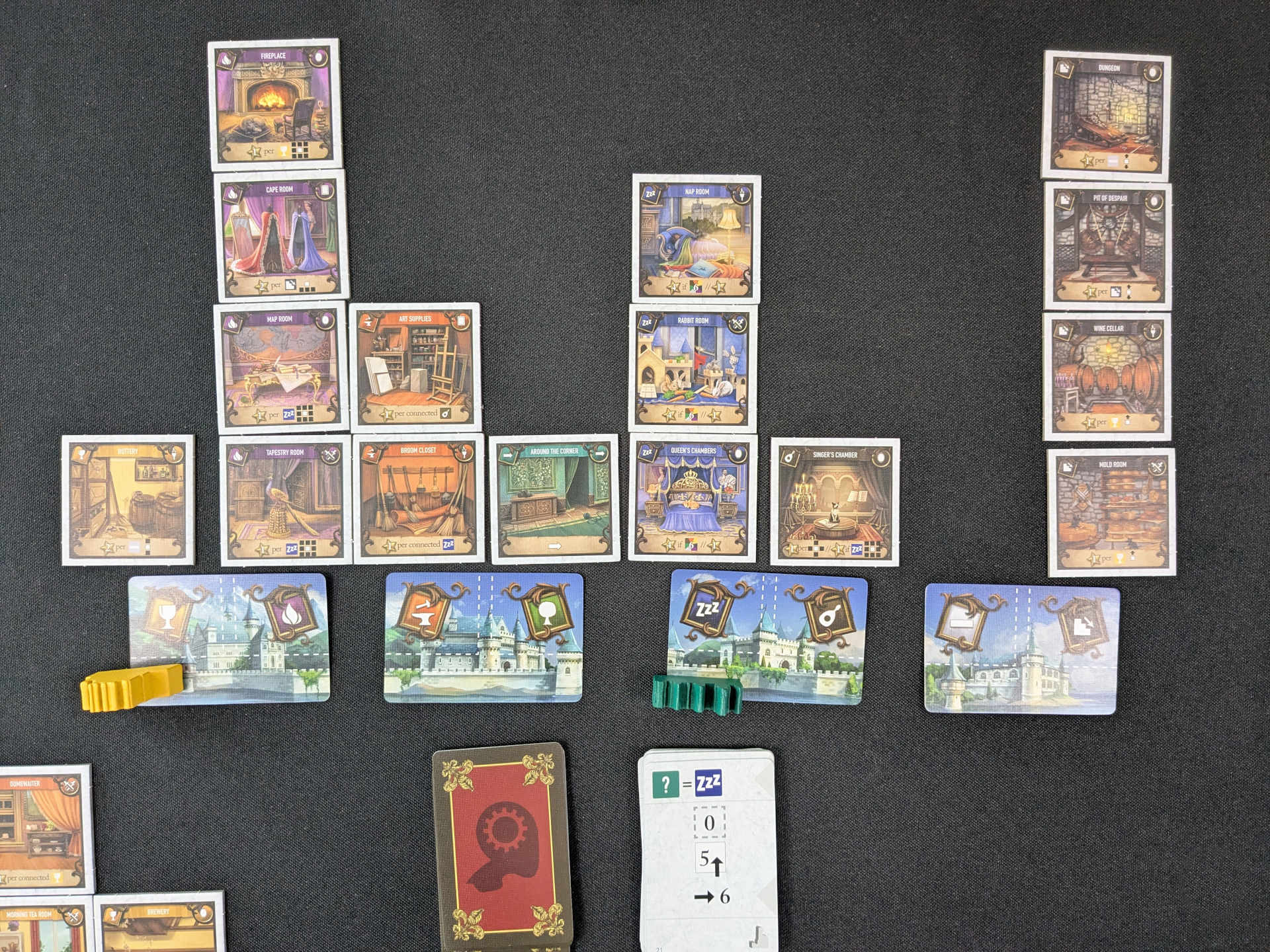
I really appreciated the reference card that tells you whose turn it is based on the hand number and number of tiles left in that hand. I only lost track of whose turn it was once in the many games that I played, but that reference saved the day. A testament to both the simplicity of the solo mode and the thoughtfulness of the designers.
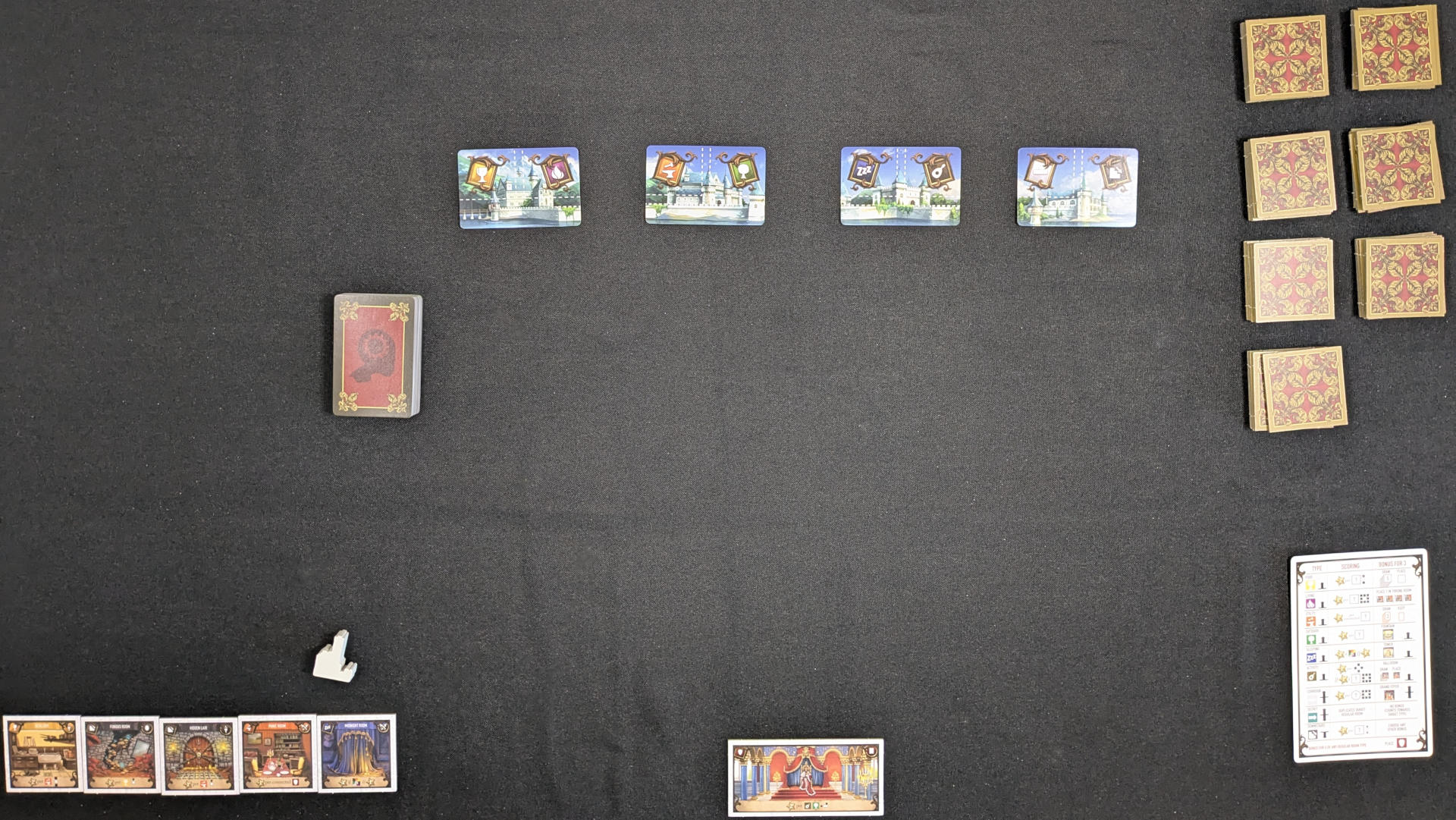
We’re also spoiled with not just one solo mode, but two in Between Two Castles Essential Edition. I also enjoyed the Introvert Variant. It’s quick to set up and play, but I didn’t find the simulated player (Fauxtoma as Pederson refers to this type) nor the single castle construction as engaging in this variant.

Overall, while both solo modes offer solid puzzle-like decision-making, that’s not usually enough to keep me engaged in the long run. I like games that I can explore in different directions or have something unexpected happen. It’s part of what makes me want to get it to the table again. With Between Two Castles Essential Edition, there’s variability, but I don’t have enough agency to decide on a strategy and follow it through to create a new experience in each game. It’s more of a tactical game about solving the puzzle with the hand you’re dealt. The castle I build is heavily dictated by random room draws. This is something that I do enjoy when playing with others, but it doesn’t make for a compelling solo game for me.
Components and Design #
Visually, the game is a joy. The artwork on each room tile is fantastic and the side perspective is like peering into a miniature dollhouse. One of my favorite small details is placing an attendant token in the throne room and lining up the token art and tile art perfectly. It’s a small thing, but it adds to the charm.
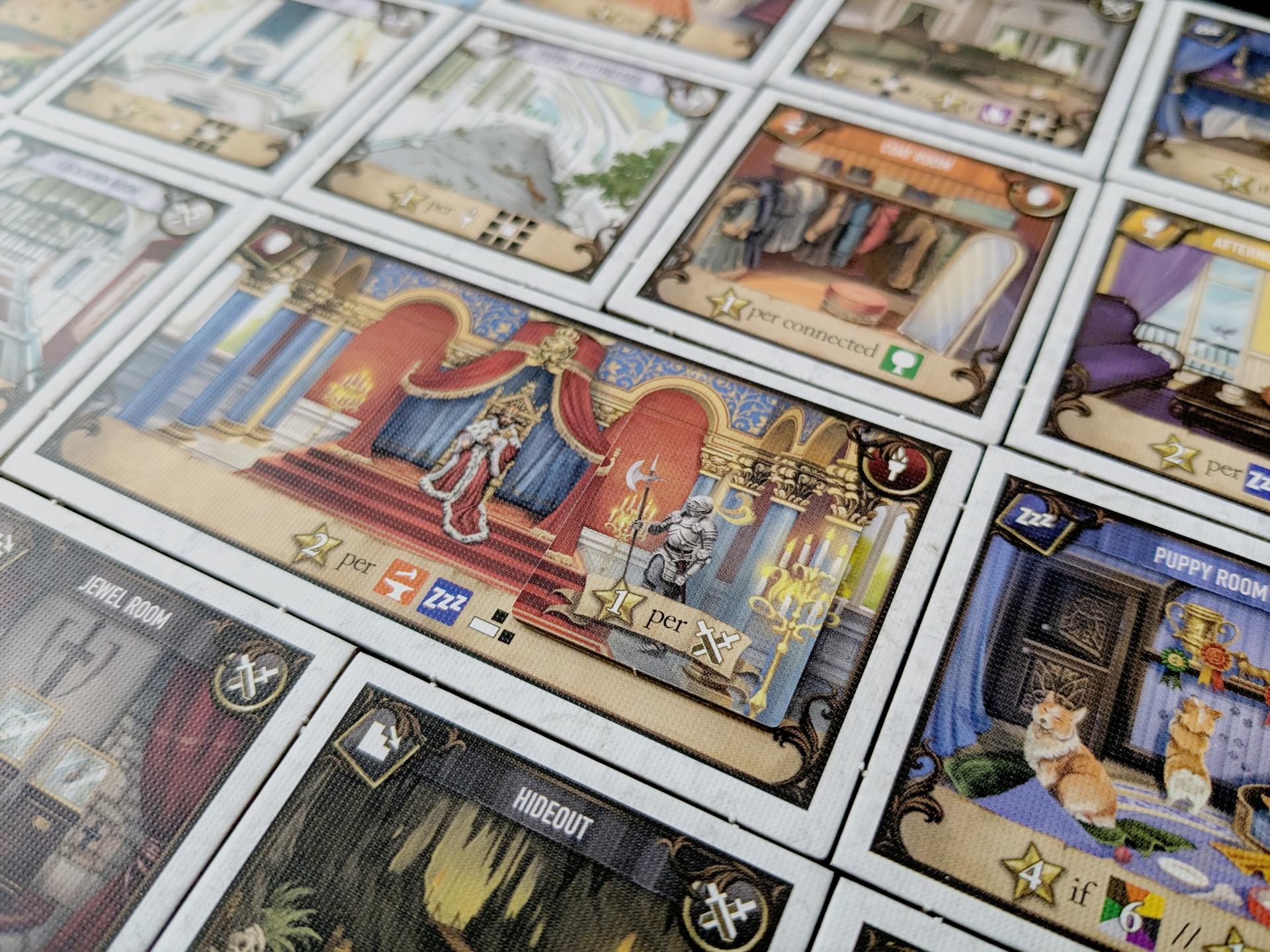
On the other hand, the side perspective makes for castle designs that are less interesting or logical compared to the top-down perspective in Castles of Mad King Ludwig. The castle shapes are constrained by placement rules that require an upstairs room to be adequately supported by a room below it. This produces castles that mostly look the same from a distance. On closer inspection, you might appreciate the unique room art per tile, but the magic fades when you realize you somehow ended up with a laundry room next to the throne room, for example. Conversely, with Castles of the Mad King Ludwig, I tend to end up with diverse castle shapes, rooms connected by doorways, and more plausible floor plans with the occasional anomaly that makes me chuckle.
I noticed that the game quietly distances itself from the “Mad King Ludwig” theme. Ludwig himself isn’t mentioned in the rulebook for this essential edition. Not a big deal, but something that caught my attention.
Lastly, the Game Trayz storage solution makes setup a breeze, and the component quality all around is solid.
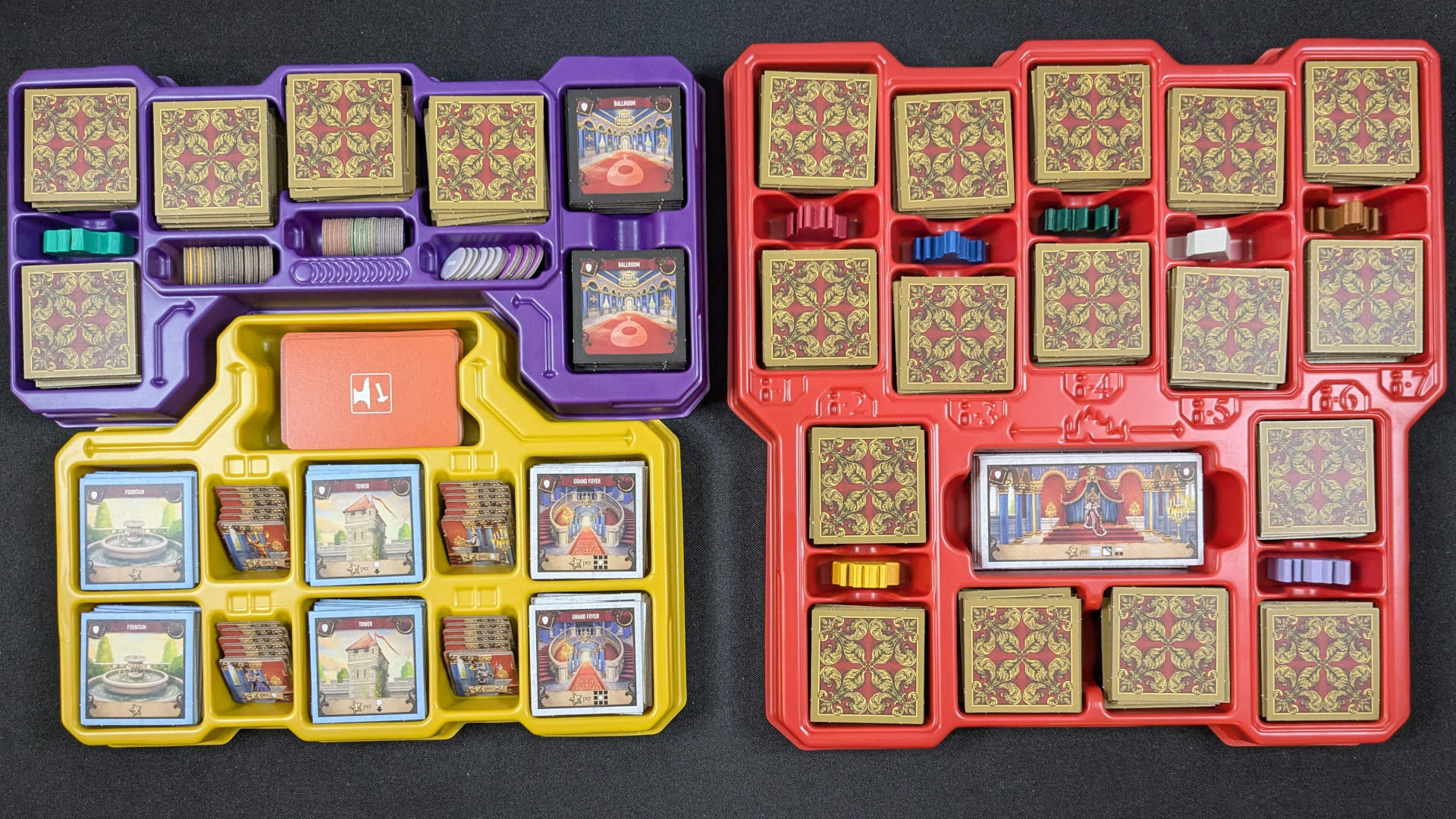
Final Thoughts #
I was intrigued to find out how a game that is so inherently multiplayer with its negotiation and collaboration mechanics could be played solo. To my surprise, I had a great time with Between Two Castles Essential Edition. The mix of cooperative and competitive play, the satisfying room scoring rules and set bonuses, and the highest-lowest score win condition make it a unique and engaging experience. While the automa is masterfully designed to create a solo experience that feels very close to the group play experience, the game itself lacks room for exploration or novelty that I look for in a long-term solo experience.
If you enjoy drafting, tile placement, and mastering puzzles, this is a great game to add to your collection.
This product was provided to us for review purposes. All opinions expressed are independent, honest, and unbiased.
- Powerful set bonuses add excitement and strategic depth to the game.
- The mix of cooperative and competitive play creates an engaging and unique challenge.
- The automa in solo mode is well-designed, capturing the cooperative spirit effectively
- The structured castle-building rules lead to less creative and less plausible layouts.
- Solo play lacks the sense of long-term exploration and novelty found in other solo games.
Learn more about how we rate board games...
